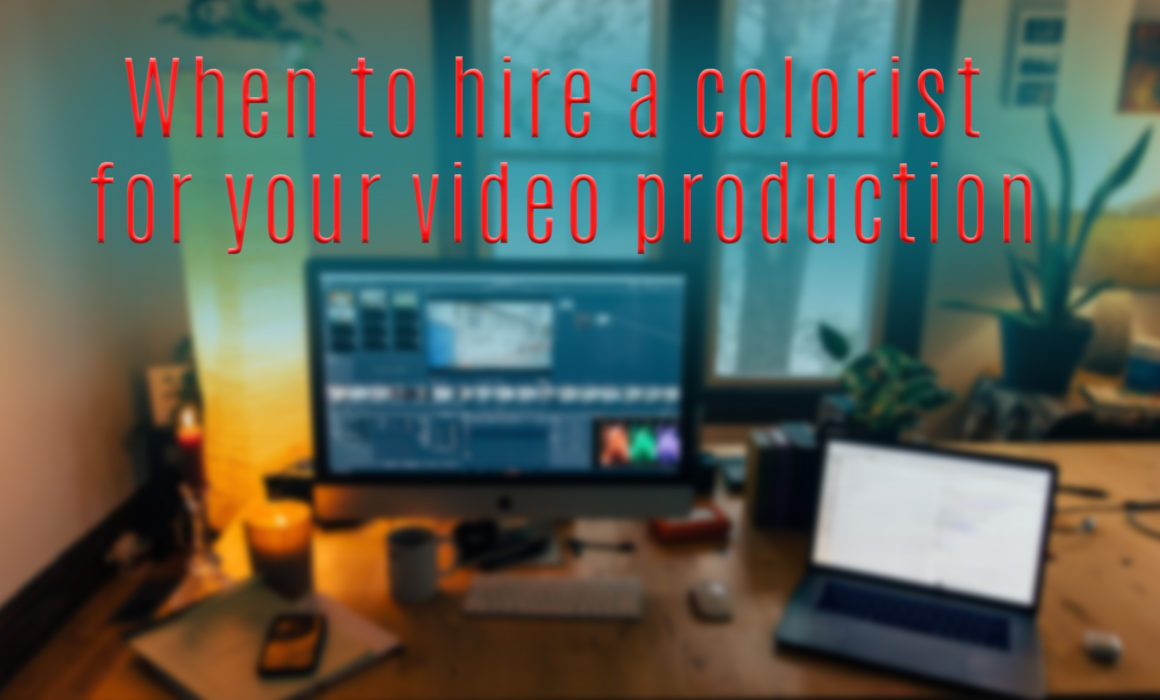When to hire a colorist for your video production?
One of the many factors that go into the final quality of a video is Its color. Maybe you are shooting your video production on a Sony Venice or an Alexa Mini LF. High-end cameras that produce high-end looks. That’s awesome! But if you are just going to put a standard LUT and not tweak the image much, you will not be maximizing the value these cameras provide. The out of the box looks will get you to a great starting point, but without fine-tuning the image, the quality will likely not be as good as a cheaper camera with a solid color grade. In this article, we’ll discuss when to hire a colorist for your video production.
But what exactly does a colorist do? Sure, maybe you are familiar with basic color grading or use tools such as Lumetri in Adobe Premiere Pro to get your video dialed in. A colorist’s whole job is to adjust the image in order to suit the look the video. This can involve, balancing different cameras. Motion tracking parts of the image. Isolating or changing colors. Etc. It’s definitely one of the most overlooked parts of video production as far as small video production operations go.
Yes, you can get yourself pretty close by yourself! But likely, by the time you get to the color correction part of the project, you’ll be burnt out and ready to move on. It’s takes a video editor some serious focus and a plethora of time to be able to accomplish both a thoughtful edit as well as a killer color grade. In this article, we’ll break down the few questions to ask yourself when trying to evaluate if you want to hire a colorist.
Do you need it to look as good as possible?
The first question to ask yourself when evaluating when to hire a colorist for your video production, is who will be watching this video? If it’s an internal video for a company that won’t get too many views, then likely this additional cost won’t make a big difference in you getting more work. Likely for these jobs, you’ll just use Lumetri or a similar grading program to get the image looking good but not the best it could. But if you feel it’s got a great story and the potential to push your portfolio further. You might consider it. At the end of the day, certain projects need to have that polished look, while others can get by with something a bit simpler. It’s really up to you to decide.
For example, when we shot our Sitpack project, we knew this was going to get a lot of external views. It was going to be displayed prominently on a big crowdfunding campaign. We also knew it had a cool story. To us, this meant it had the potential to bring more work and would help generate revenue for the crowdfunding campaign. We decided to hire a colorist and we feel it was one of the best decisions we made on the project! Obviously, we needed money to make this decision, and because we had a little bit left over at the end of the project, it wasn’t a hard choice.
Do you have time to send your project to a colorist?
The next question to ask yourself is if you and your team have time to send it to a colorist. Although the process isn’t exactly super tough, it definitely takes time. You need to send the original project files either over the internet or on a hard drive. You’d also need to export the data from your timeline. Likely in an EDL format. If you used effects such as warp stabilizer or other titles or graphics, you need to remove those and then add them back in once the colorist sends the project back to you. Here’s a cool guide on how to prep your project for color correction. This can be frustrating if you forget something!
Color prepping
The next step of the process once you have prepped it for color is to wait for them to color the project. Some colorists are pretty fast for a relatively simple project. Others take a lot of time and are extremely meticulous. You can also attend virtual color sessions to dial in the look even more. Be sure you are using a calibrated monitor for this. Once they start to create the base look for the project, they will likely ask you for feedback before continuing on to make more granular choices. After this, they will send the video to you to review. Hopefully, it’s looking great, but if not, you may have to spend another day or two to get the image precisely how you want!
Once the colorist has finished the project, they’ll then export all the clips back to you(usually with handles for adjustment if needed). At this point, you’ll need to relink all the files and then add back in all your effects and graphics. When evaluating when to hire a colorist for your video production, definitely don’t forget to budget for at least three days to round trip the whole project.
Bonus time saving tip!
While we are on the topic of speeding up your workflow, one of the newest trends in video production is camera to cloud. This will allow your editor to get the project that much faster! You’ll be able to save at least a day at the beginning of your project, as your editor can literally start editing the project as your shooting day progresses. The cost for something like this is the Teradek Cube 655 plus the Frame.io plan! So perhaps around $2200 to get set up for a year. Then you are off to the races. This can allow you to have more time for your color colorection.
Are you matching different cameras?
Let’s say you got the time and the money, but aren’t exactly sure if it’s going to be portfolio-worthy. This is a tricky spot to be in. Do you just finish the project quickly and move on? Do you have at least a basic understanding of matching cameras? Did you shoot with a color chart? One of the big questions to consider when deciding to hire a colorist for your video production is if you’ll be matching different cameras. All cameras handle color, contrast, and highlight roll-off slightly differently.
If you shot with different brands of cameras, didn’t use a color chart and you have a high-end brand to maintain, we’d highly recommend hiring a colorist. We typically say that if you can get 95% of the image there, then it’s okay to do it yourself. But if you really want to push your brand forward. Hire a colorist!
If you do want to consider doing it yourself and you have a color checker, check out this Youtube video by Tom Antos!
Remember, shooting with different cameras, is just one of the factors to consider when evaluating if you want to hire a colorist.
Do you have the budget?
The last question to ask yourself, is if you have the budget? First, you might check out our article on budgeting for film production. We break down a few different ways to maximize your budget. As there are many factors that go into a budget, color is just one of them. We’ve spent everywhere from $500 for a colorist, up to $1500 for a more complicated commercial. Many colorists, charge much more than this. Sometimes in the range of $500/hr! They are incredibly fast at making tweaks to get the best image possible! It’s about finding someone who’s in your price range, who will still deliver incredible looks at a rate that is sustainable.
Remember, if you are going to rent a top-tier camera and use cinema glass, hiring a colorist is pretty much a non-negotiable! Don’t skimp on getting that image to look its absolute best!
Wrap up
Thanks for taking the time to read our article on when to hire a colorist for your video production. We know there are many factors to consider when you are putting together a video. Don’t let the final polish stop your project from being the best it can. That said, also be sure that your colorist does your project justice! If they are really cheap, there is likely a reason!
Luma Creative is a San Francisco Bay area video production company focused on getting the best looks for our client. If you’d like to learn more, reach out!

